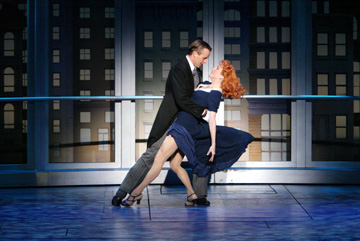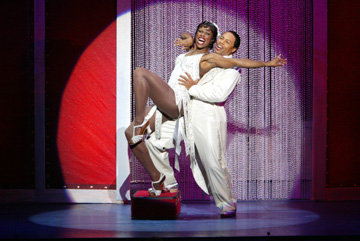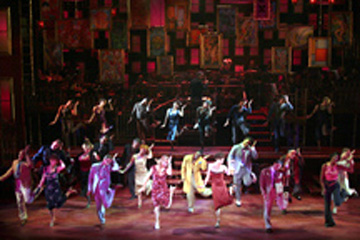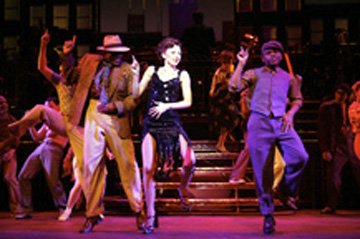Two Musicals Where The Dancing Matters
NEVER
GONNA DANCE
Music by Jerome Kern; Lyrics by Dorothy Fields and others; Book by Jeffrey
Hatcher
Directed by Michael Greif; Choreographed by Jerry Mitchell
Broadhurst Theater
New York, NY
December 3, 2003
WONDERFUL
TOWN
Music by Leonard Bernstein; Lyrics by Betty Comden & Adolph Green;
Book by Joseph Fields and Jerome Chodorov
Directed and Choreographed by Kathleen Marshall
Al Hirschfeld Theater
New York, NY
December 4, 2003
By
Susan Reiter
copyright
© 2003 by Susan Reiter
On Broadway these days you can find recent musicals celebrating the gaudy excesses of the 1980s (Taboo, The Boy from Oz) or bouncing on the exuberant beat of pre-Beatles rock & roll (Hairspray, Little Shop of Horrors). But if you want a show where dance really provides the highlights, you need to travel back to the 1930s, where the action of these two new arrivals takes place.
Set in 1936, Never Gonna Dance is based on the Astaire-Rogers film Swing Time, and has two dancers as its central characters, as well as scenes set at a dancing school and an "amateur" dance competition. Its two leading performers, both veterans of Broadway dance ensembles, were cast for their dancing strengths. All of its music is by Jerome Kern: the score includes five of the six songs heard in Swing Time, plus 12 additional songs from other shows and films. This approach, of creating a "new" period musical from existing songs, is similar to that used for the two Gershwin-scored musicals My One and Only and Crazy for You.
While it is set in 1935, Wonderful Town has a score that was written—during a now-legendary month-long creative whirlwind—in late 1952 by three fun-loving collaborators looking back fondly at a period when they were in their late teens. It has a great Leonard Bernstein score that bridges the youthful ingenuity and sass of On the Town (1944) and the deeper and bolder innovations of West Side Story (1957).

Both shows deal with young hopefuls arriving in New York filled with goals and dreams—and, given that's it's the depression, lack of funds. We briefly see Lucky Garnett, the hero of Never Gonna Dance, back in Pennsylvania just long enough to learn that he's a hoofer who's giving his final performance before heading off to marry a classy local girl. Late for his own wedding, he's confronted by her father, who wants him to prove he can earn enough to support her by some means other than dancing. He heads for New York, still wearing his wedding outfit, and from the moment he arrives is fated to do nothing besides dancing.
One of the show's highlights is "I Won't Dance," the extended number in Grand Central Station, where Lucky (Noah Racey) arrives and is enveloped by danceable rhythms as every turn. The thud of the newspaper vendor's piles, the chants of the coffee and hot dog vendors, the staccato steps of ladies in heels—all Lucky wants to do is inhabit those rhythms with his feet. But he's just arrived on a mission not to dance—so he fights that urge as much as he can. Racey, a tall, lanky, wonderfully genuine performer, seems to be channeling Bill Irwin as he bottles those rhythms that threaten to take over his body. Of course he eventually gives in, and in true Hollywood style soon has the station's entire population dancing with him.
There are many clever touches in this number—the way set pieces slide in and out and props are used. An array of social types—businessmen, vendors, ladies out shopping, secretaries—weave in and out, and the central character or Penny Carroll is seen buying her morning coffee. The perkier tap rhythms at one point give way to a more bluesy sound (Zane Mark did the extensive dance music arrangements) as Racey performs some deft variations around three businessmen reading their newspapers.
The scene can be seen as an homage to Fred Astaire, as it evokes The Band Wagon (and certainly the presence of a shoeshine guy is a nod to Astaire). It really gets the show moving, but that momentum is somehow lost once the main concern becomes the tentative romance between Lucky and Penny, who teaches at the Swing Time Dance Studio (where the signs say things like "Dance for Romance"). Nancy Lemenager, who plays Penny, can't match Racey's ease and naturalness. She has beautiful line and dances with flair, but comes across as tense and un-spontaneous. She is not called upon to sing as much as he is (his voice is pleasant and engaging), but the pinched, effortful way she sang "I'm Old Fashioned" did not help endear her character to the audience. The unflattering red wig did not do anything to enhance her appeal.

The performer in Never Gonna Dance with real star quality is Karen Ziemba, a Broadway veteran whose last appearance, an all-dancing role in Contact, won her a Tony Award. In the past decade, she and Charlotte D'Amboise have been Broadway's finest leading ladies when to comes to dancing roles, but Ziemba's singing is also stellar, and she proves herself a true triple-threat in this show. As Mabel, the pal/encourager of Penny, she's an ebullient, big-hearted, good-humored gal. Her numbers are standouts—whether she's easing into a courtship at the automat or leading the entire dance studio in the Shimmy, she can do it all. Her dancing opportunities here a limited but she knows how to make the most of them. And her big song, "I Got Love," is sung with such warmth and openness that you can feel it filling all of Central Park, where the scene is set.
The eminent Broadway designer Robin Wagner evokes the park at night wonderfully, with a stone bridge and a moonlit sky that make you feel you're there. His many and varied sets for the show appear and vanish with magical ease, and for the climactic ballroom number ("Never Gonna Dance," with Penny wearing a dress reminiscent of Ginger's in the film) he uses a row of mirrors that enhance the old-fashioned magic.
 Since
this Wonderful Town grew out of Kathleen Marshall's
production in the Encores series that offers musicals in concert, scenery
is the last thing on its mind. As at Encores, the orchestra is onstage—a
full 24 pieces, giving Bernstein his due, and then some, under the exuberant
direction of Encore's mainstay Rob Fisher. When the curtain rises for
the overture, the art-deco-style setting in which the orchestra is placed
seems to leave almost no room for anything else. But part of the magic
of this production is that once the action begins—in front of, and
at times above the orchestra—all sense of limitation is gone.
Since
this Wonderful Town grew out of Kathleen Marshall's
production in the Encores series that offers musicals in concert, scenery
is the last thing on its mind. As at Encores, the orchestra is onstage—a
full 24 pieces, giving Bernstein his due, and then some, under the exuberant
direction of Encore's mainstay Rob Fisher. When the curtain rises for
the overture, the art-deco-style setting in which the orchestra is placed
seems to leave almost no room for anything else. But part of the magic
of this production is that once the action begins—in front of, and
at times above the orchestra—all sense of limitation is gone.
John Lee Beatty has designed what scenery is needed to set the scene—skylines behind the orchestra, windows and minimal room settings—and Marshall's ingenuity does the rest. The orchestra, behind a scrim, remains a steady but unobtrusive presence. The transitions from outside on Christopher Stree—the show is lovingly set in "bohemian" Greenwich Village—to inside the basement apartment where the Sherwood sisters live, are handled with extreme grace. There are more levels available for Marshall's action than we realize, as the show unfolds and the space is brilliantly utilized.
This is a production where everything has come together terrifically. At the center is Donna Murphy as Ruth Sherwood, the older, more jaded of the two sisters who have come from Ohio. The role may have been created for Rosalind Russell, but Murphy inhabits its wisecracks, eager goofiness and subdued romance magnificently. Her mellow, throaty voice can slide into scat singing or Louis Armstrong-like low notes. Leggy and lean, she dances mostly in comedic numbers, giving in with abandon to the wackiness of the hilarious "Conga" with six Brazilian naval officers, and discovers her sense of rhythm with delightful awkwardness in the number "Swing."
 This
number, late in the second act, is just one of Marshall's delectable effervescent
concoctions. It builds from Murphy plaintively trying to interest sneering
passersby in her pitch for a local nightclub, to an brassy, uninhibited
full-ensemble explosion that evokes memories of "Cool" from
West Side Story. Then, as a bonus—since there is a delicious musical
coda after nearly every numbe—we get four couples in a vigorous
lindy hop.
This
number, late in the second act, is just one of Marshall's delectable effervescent
concoctions. It builds from Murphy plaintively trying to interest sneering
passersby in her pitch for a local nightclub, to an brassy, uninhibited
full-ensemble explosion that evokes memories of "Cool" from
West Side Story. Then, as a bonus—since there is a delicious musical
coda after nearly every numbe—we get four couples in a vigorous
lindy hop.
Marshall gets to create her own extended number that brings New York City to life. It's called "Conquering New York" and is more a mimed sequence with bits of dance threaded through. With swift economy and exquisitely timed wit, we follow Ruth (a writer) and her younger sister Eileen (a would-be actress) on their first day out trying to find work in the big city. The subway ride, a dance audition, an unnerving wait for an interview - it all rides along the urgent, propulsive rhythms of Bernstein's music, and when it's over we've learned a lot about the personalities of the two sisters.
There is further evidence of Marshall's deft touch and fine ear in the opening number, "Christopher Street," in which a mad array of Village types dash through as a plodding group of camera-laden tourists are being shown around by a guide. Marshall deftly nails the full range of artistic clichés, including three hands-to-forehead women who obviously study at the Martha Graham School. Equally wonderful is the way the ensemble dancers turn into admiring kids who surround Wreck, the huge, bulky football player (an endearing Raymond Jaramillo McLeod) in his very funny "Pass the Football," then enact their own game complete with a slow-motion replay.
There are delights threaded throughout the show, especially the Act Two opener, in which a bunch of dancing cops manage to stop the show, leaving the audience in stitches. And when every single member of the cast is suddenly bouncing and jerking impishly to the 'Wrong Note Rag," the stage threatens to levitate, the joy is so infectious.
Chief among the cast's many delights are Jennifer Westfeldt as the overly sweet, ingenuous Eileen, whom no man can resist, and Gregg Edelman, in fine voice and displaying fine comic flair as the editor to whom Ruth brings her stories.
Wonderful Town was never made into a film. For some reason, two years later the same play (My Sister Eileen) on which it is based was made into a different musical by that same title, with a score by Jule Styne. It's a perfectly agreeable, typically bland 1950s movie musical, and the songs sound like they're on a kindergarten level once you know how inventively and irreverently Bernstein and his collaborators transformed the same material. It took fifty years for Wonderful Town to make its return to Broadway—welcome back!
Photos:
First: Noah Racey as Lucky Garnett and Nancy Lemenager as Penny
Carroll in Never Gonna Dance. Photo ©2003 Joan Marcus.
Second: Deidre
Goodwin as Velma and Eugene Fleming as Spud in Never Gonna Dance.
Photo ©2003 Joan Marcus.
Third: The Wonderful Town Company. Photo ©2003 by Paul Kolnik.
Fourth:
Donna Murphy and The Wonderful Town Company. Photo ©2003
by Paul Kolnik.
Originally
published:
www.danceviewtimes.com
Volume 1, Number 11
December 8, 2003
Copyright
©2003 by Susan
Reiter
|
|